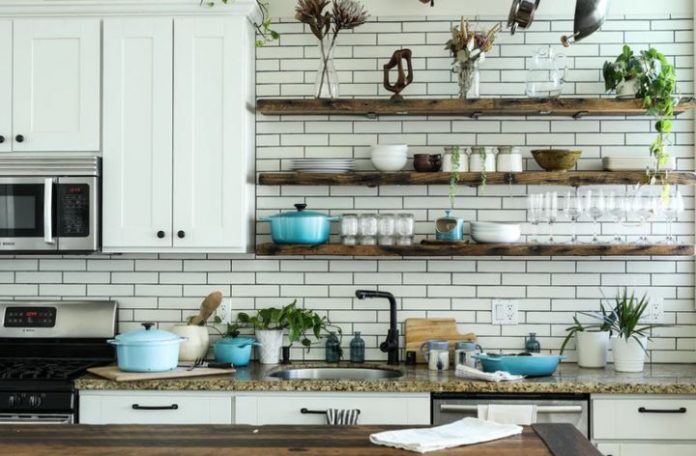A basic kitchen needs a selection of pots and pans, some basic gadgets, and a collection of common spices and condiments.
Pots and Pans:
A minimum set includes a small frying pan, a one-quart saucepan with cover, a two-quart saucepan with cover, a large frying pan with cover, and a large pot (for spaghetti, stew, pot roast, or homemade soup.)
If you are cooking for more than one person, get two each of the frying pans and saucepans. Covers are optional for the frying pans, but try to get a cover to fit at least one.
Good quality pans spread the heat evenly so that food does not burn in the area of the pan and stay undercooked in another. The bottom of a good pan sits flat on the stove. Cheap pans wear out fast and cost more in the long run.
Stainless steel pans with a porcelain coating or a copper bottom are excellent. Stay away from aluminum pans. They get bent out of shape easily and do not last. There have also been some health warnings about cooking in aluminum, but no real proof of any danger.
When using pans with a non-stick coating, turn the heat up only as far as is necessary, and only use wooden or plastic tools. Wipe the pan clean in soapy water. A plastic or nylon net scrubber can be used, but never use steel wool pads.
If you do not burn the food onto the pan, and you wash it while the food is still fresh and moist, it will be easy to clean. If you have birds as pets, you may want to avoid non-stick coatings. If you use them, be sure not to overheat them. The coating can release fumes that can kill a bird.
Some other useful tools are a slow cooker, a wok (for Chinese cooking), toaster, microwave, blender, food processor, electric mixer, and an electric knife. There are also bread machines available at reasonable prices that produce a fresh hot loaf of bread rapidly.
Most machines also have a delay setting to allow one to place the ingredients in the machine hours before the bread is needed, so the machine finishes just in time for dinner.
Basic Gadgets:
You will need some wooden spoons. Get a selection of sizes and handle lengths. These are always handy and they will not damage your non-stick coatings. Unlike metal tools, they do not get too hot to handle.
You will also want a collection of spatulas in different sizes and shapes. The lightweight spatula that will flip an egg may not be strong enough for a hamburger.
Sometimes a narrow spatula is all that will fit in a pan, and sometimes a wide one is needed to get under whatever needs to be turned or lifted.
Whisks come in various sizes. They are very handy for mixing lightweight ingredients quickly and are easier to get out and later to clean than a blender or mixer.
Get a good set of knives. Cheap ones make the job of cutting more difficult and they wear out fast. With the knives, you will need a good cutting board. A cutting board provides a flat working surface and protects your counters.
Plastic cutting boards are easier to clean than wooden ones. Never cut vegetables that will be eaten raw on a cutting board that was used to cut raw meat unless you thoroughly clean the board first.
You will also need a selection of measuring tools. Measuring cups for dry ingredients and measuring spoons come in sets. Get a set of each. You will need a measuring cup for liquids, too.
A one-cup measure is probably sufficient, but two-cup and quart measures are also useful. If you want to be precise in your measurements for dietary requirements, buy a food scale, and measure your portions until you get used to the sizes and can estimate accurately without weighing everything.
A lot of canned products are now being packaged with pop tops, but get a good can opener for the others. There are some electrics that sell for reasonable prices and do a good job but get a manual one too. When the power goes out, it can be frustrating not to be able to open the cans.
Spices and Condiments:
Salt and pepper go without saying. Some dried minced onion peps up a lot of recipes. Garlic is available fresh or in dried, chopped form or as a powder. Caution: make sure you know the difference between garlic powder and garlic salt. Garlic powder makes great garlic bread; garlic salt makes VERY salty garlic bread.
Oregano or “Italian Seasoning,” gives an Italian flavor to anything. A bay leaf cooked in stew brings out the flavor of the other ingredients.
Paprika is a red powder used mainly for appearance, but it has been linked to some health benefits. If you like things hot, try sprinkling some cayenne pepper or chili powder on your food.
Basic condiments include ketchup, mustard, relish, and mayonnaise. There are all sorts of mustard varieties available. You can probably find traditional yellow mustard, Dijon, spicy brown, honey, and hot Chinese mustard, just to name a few.
Explore your local market and see what looks good. Be adventurous, but buy the smallest size, so you do not have a lot to discard if you do not like it.
Other condiments to try are steak sauces, barbecue sauces, tartar sauce, and various stir-fry sauces. Read the labels. If sugar is one of the first few ingredients, forget it. Ingredient labels list the ingredients in descending order. The main ingredient is first, then the others, with the least one last.

